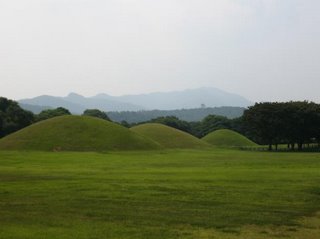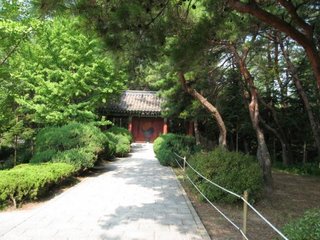Silla dynasty epicenter: Gyeongju

(Note: I apologize profusely for the quality of these uploaded photos. I am unsure why my 8-megapixel camera which produces photos in the file size of 2-4Mb upload to such poor quality. I'll work on this and hope to improve this over time. If anyone has any suggestions/experience with Blogger.com in this regard, please let me know!)
Over the long holiday weekend...
(August 15th is Korea's National Day -- the day commemorating the freedom of Korea from Japanese occupation which began in 1910 and ended with Japanese surrender and the end of WWII. This day brings me pause because my father's father was killed for his involvement in the resistance movement.),
I visited Gyeongju, the historical capital of the Silla dynasty (pronounced /shil-la/) which contains many artifacts, tombs, temples and pagodas of united Silla dynasty (668-918 A.D.). Prior to the united Silla dynasty era was the Three Kingdoms era; the Silla dynasty united the peninsula and ushered in 250 years of peace and prosperity. During this period of history, Korean culture, creativity and the arts flourished, and Buddhism became prominent in Korea.
Gyeongju looks like this: a multitude of mountains strewn across expansive valleys reaching the East Sea. Due to the moisture of the recent monsoons, the fields are of brightest-colored wild flowers and the forests are new-growth green and fertile. And yet the sky remains tentative, almost brooding, with the remnants and memories of the monsoons.




Monuments and sites of historical interest can be reached by foot or bicycle, and so I did a lot of walking. Various kings, generals and public figures are enshrined across Gyeongju in massive tumuli, some high as 30 feet or more and or more than 60 feet in diameter! I found these places to be serene and in consonance with the nature (immitating the shape and form of the mountains and surroundings of Gyeongju). I felt very rewarded to find these places and have some of them virtually to myself on a hot, humid Sunday afternoon.


On Monday, I took a tour bus to go to some of the places I could not reach by foot, bicycle or public transport. One highlight was a giant buddha, a carving in a rock wall, gazing upon me. Also, I went to the coast to view the only known sea tomb, elaborately described in the will of the deceased and constructed for 30 years. From another direction, I loved the way the clouds were touching down upon the water only a short distance away from me, as if I could walk there. I didn't even try to take a picture, I knew no camera could capture it.


While I am glad I went for what I saw on the second day, this greatly reminded me that I am not a tour-taking type (Alas, I don't like to be shuffled like chattel through historical sites among some 50-odd people.)
On my last day, I meandered about Gyeongju National Park replete with forest, pond, tumuli and other historical sites.


Here is a link that I found to some of the historical sites, since my pictures and experience could not possibly capture all there is in Gyeongju:
http://www.koreatips.net/english/cities/gyeongju_attraction01.html
Epilogue
I think peace and creativity hand-in-hand is a lesson for all time.



1 Comments:
Thanks, Jim. Unfortunately, I have no portable software to re-save the file to a smaller file size (except MS Paint which degrades the quality even further). I think everyone (most especially me) will just have to suffer my poor-quality photo-posts (unless someone volunteers to be my webmaster and can do this from home).
Post a Comment
<< Home